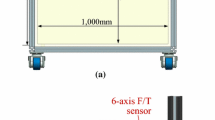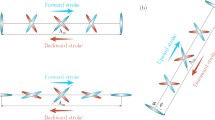Abstract
Over the past several decades, there has been great interest in understanding the aerodynamics of flapping flight, namely the two flight modes of hovering and forward flight. However, there has been little focus on the aerodynamic characteristics during takeoff of insects. In a previous study we found that the Rhinoceros Beetle (Trypoxylusdichotomus) takes off without jumping, which is uncommon for other insects. In this study we built a scaled-up electromechanical model of a flapping wing and investigated fluid flow around the beetle’s wing model. In particular, the present dynamically scaled mechanical model has the wing kinematics pattern achieved from the real beetle’s wing kinematics during takeoff. In addition, we could systematically change the three-dimensional inclined motion of the flapping model through each stroke. We used digital particle image velocimetry with high spatial resolution, and were able to qualitatively and quantitatively study the flow field around the wing at a Reynolds number of approximately 10,000. The present results provide insight into the aerodynamics and the evolution of vortical structures, as well as the ground effect experienced by a beetle’s wing during takeoff. The main unsteady mechanisms of beetles have been identified and intensively analyzed as the stability of the leading edge vortex (LEV) during strokes, the delayed stall during upstroke, the rotational circulation in pronation periods, and wake capture in supination periods. Due to the ground effect, the LEV was enhanced during half downstroke, and the lift force could thus be increased to lift the beetle during takeoff. This is useful for researchers in developing a micro air vehicle that has a beetle-like flapping wing motion.

















Similar content being viewed by others
References
Ahmed MR, Sharma SD (2005) An investigation on the aerodynamics of a symmetrical airfoil in ground effect. Exp Thermal Fluid Sci 29:633–647
Ahmed MR, Takasaki T, Kohama Y (2007) Aerodynamics of a NACA4412 airfoil in ground effect. AIAA J 45:37–47
Ansari S, Phillips N, Stabler G, Wilkins P, Żbikowski R, Knowles K (2009) Experimental investigation of some aspects of insect-like flapping flight aerodynamics for application to micro air vehicles. Exp Fluids 46:777–798. doi:10.1007/s00348-009-0661-2
Beem H, Rival D, Triantafyllou M (2012) On the stabilization of leading-edge vortices with spanwise flow. Exp Fluids 52:511–517. doi:10.1007/s00348-011-1241-9
Birch JM, Dickinson MH (2001) Spanwise flow and the attachment of the leading-edge vortex on insect wings. Nature 412:729–733
Birch JM, Dickson WB, Dickinson MH (2004) Force production and flow structure of the leading edge vortex on flapping wings at high and low Reynolds numbers. J Exp Biol 207:1063–1072. doi:10.1242/jeb.00848
Bomphrey RJ, Lawson NJ, Harding NJ, Taylor GK, Thomas ALR (2005) The aerodynamics of Manducasexta: digital particle image velocimetry analysis of the leading-edge vortex. J Exp Biol 208:1079–1094. doi:10.1242/jeb.01471
Card G, Dickinson M (2008) Performance trade-offs in the flight initiation of Drosophila. J Exp Biol 211:341–353. doi:10.1242/jeb.012682
Cheng N-S (2008) Formula for the viscosity of a glycerol–water mixture. Ind Eng Chem Res 47:3285–3288. doi:10.1021/ie071349z
David L, Jardin T, Braud P, Farcy A (2012) Time-resolved scanning tomography PIV measurements around a flapping wing. Exp Fluids 52:857–864. doi:10.1007/s00348-011-1148-5
Dickinson MH, Lehmann F-O, Sane SP (1999) Wing rotation and the aerodynamic basis of insect flight. Science 284:1954–1960. doi:10.1126/science.284.5422.1954
Ellington CP (1984) The aerodynamics of hovering insect flight. III. Kinematics. Philos Trans R Soc Lond B Biol Sci 305:41–78
Ellington CP, Berg CVD, Willmott AP, Thomas AIR (1996) Leading-edge vortices in insect flight. Nature 384:626–630. doi:10.1038/384626a0
Gao T, Liu N-s, Lu X-y (2008) Numerical analysis of the ground effect on insect hovering. J Hydrodyn Ser B 20:17–22
Hedrick TL (2008) Software techniques for two- and three-dimensional kinematic measurements of biological and biomimetic systems. Bioinspir Biomim 3:034001. doi:10.1088/1748-3182/3/3/034001
Hyungmin P, Haecheon C (2012) Kinematic control of aerodynamic forces on an inclined flapping wing with asymmetric strokes. Bioinspir Biomim 7:016008
Ishihara D, Yamashita Y, Horie T, Yoshida S, Niho T (2009) Passive maintenance of high angle of attack and its lift generation during flapping translation in crane fly wing. J Exp Biol 212:3882–3891. doi:10.1242/jeb.030684
Kim D, Gharib M (2010) Experimental study of three-dimensional vortex structures in translating and rotating plates. Exp Fluids 49:329–339. doi:10.1007/s00348-010-0872-6
Kurtulus DF, David L, Farcy A, Alemdaroglu N (2008) Aerodynamic characteristics of flapping motion in hover. Exp Fluids 44:23–36. doi:10.1007/s00348-007-0369-0
Le TQ, Byun D, Saputra P, Ko JH, Park HC, Kim M (2010) Numerical investigation of the aerodynamic characteristics of a hovering Coleopteran insect. J Theor Biol 266:485–495
Le TQ, Truong TV, Park SH, et al. (2013) Improvement of the aerodynamic performance by wing flexibility and elytra–hind wing interaction of a beetle during forward flight. J R Soc Interface 10 doi:10.1098/rsif.2013.0312
Lehmann F-O (2004) The mechanisms of lift enhancement in insect flight. Naturwissenschaften 91:101–122. doi:10.1007/s00114-004-0502-3
Lehmann F-O (2009) Wing–wake interaction reduces power consumption in insect tandem wings. Exp Fluids 46:765–775. doi:10.1007/s00348-008-0595-0
Liang Z, Xinyan D, Sanjay PS (2011) Modulation of leading edge vorticity and aerodynamic forces in flexible flapping wings. Bioinspir Biomim 6:036007
Lu Y, Shen GX (2008) Three-dimensional flow structures and evolution of the leading-edge vortices on a flapping wing. J Exp Biol 211:1221–1230. doi:10.1242/jeb.010652
Lu Y, Shen GX, Lai GJ (2006) Dual leading-edge vortices on flapping wings. J Exp Biol 209:5005–5016. doi:10.1242/jeb.02614
Lua KB, Lim TT, Yeo KS (2008) Aerodynamic forces and flow fields of a two-dimensional hovering wing. Exp Fluids 45(6):1047–1065
Lua K, Lai K, Lim T, Yeo K (2010) On the aerodynamic characteristics of hovering rigid and flexible hawkmoth-like wings. Exp Fluids 49:1263–1291. doi:10.1007/s00348-010-0873-5
Park H, Choi HC (2012) Kinematic control of aerodynamic forces on an inclined flapping wing with asymmetric strokes. Bioinspir Biomim 7:016008. doi:10.1088/1748-3182/7/1/016008
Poelma C, Dickson W, Dickinson M (2006) Time-resolved reconstruction of the full velocity field around a dynamically-scaled flapping wing. Exp Fluids 41:213–225. doi:10.1007/s00348-006-0172-3
Ramamurti R, Sandberg WC (2002) A three-dimensional computational study of the aerodynamic mechanisms of insect flight. J Exp Biol 205:1507–1518
Rayner JMV (1991) On the aerodynamics of animal flight in ground effect. Philos Trans R Soc Lond B Biol Sci 334:119–128. doi:10.1098/rstb.1991.0101
Sane SP (2003) The aerodynamics of insect flight. J Exp Biol 206:4191
Sane SP, Dickinson MH (2001) The control of flight force by a flapping wing: lift and drag production. J Exp Biol 204:2607–2626
Sane SP, Dickinson MH (2002) The aerodynamic effects of wing rotation and a revised quasi-steady model of flapping flight. J Exp Biol 205:1087–1096
Shyy W, Lian Y, Tang J, Viieru D, Liu H (2008) Aerodynamics of low Reynold Number flyers. Cambridge University Press, Cambridge
Sitorus PE, Park HC, Byun D, Goo NS, Han CH (2010) The role of Elytra in beetle flight: I. Generation of Quasi-Static Aerodynamic Forces. J Bionic Eng 7:354–363. doi:10.1016/S1672-6529(10)60267-3
Srygley RB, Thomas ALR (2002) Unconventional lift-generating mechanisms in free-flying butterflies. Nature 420:660–664. http://www.nature.com/nature/journal/v420/n6916/suppinfo/nature01223_S1.html
Sudhakar Y, Vengadesan S (2010) Flight force production by flapping insect wings in inclined stroke plane kinematics. Comput Fluids 39:683–695
Sun M, Tang J (2002) Unsteady aerodynamic force generation by a model fruit fly wing in flapping motion. J Exp Biol 205:55
Thomas ALR, Taylor GK, Srygley RB, Nudds RL, Bomphrey RJ (2004) Dragonfly flight: free-flight and tethered flow visualizations reveal a diverse array of unsteady lift-generating mechanisms, controlled primarily via angle of attack. J Exp Biol 207:4299–4323. doi:10.1242/jeb.01262
Tyson LH (2008) Software techniques for two- and three-dimensional kinematic measurements of biological and biomimetic systems. Bioinspir Biomim 3:034001
Van Truong T, Le TQ, Byun D, Park HC (2011) Take of mechanics in beetle flight. In: International conference on intelligent unmaned system 2011, Chiba, Japan, pp 74
Van Truong T, Le TQ, Byun D, Park HC, Kim M (2012a) Flexible wing kinematics of a free-flying beetle (Rhinoceros beetle Trypoxylusdichotomus). J Bionic Eng 9:177–184
Van Truong T, Le TQ, Tran HT, Park HC, Yoon KJ, Byun D (2012b) Flow visualization of rhinoceros beetle (Trypoxylusdichotomus) in free flight. J Bionic Eng 9:304–314
Weis-Fogh T (1973) Quick estimates of flight fitness in hovering animals, including novel mechanisms for lift production. J Exp Biol 59:169–230
Willmott A, Ellington C (1997) The mechanics of flight in the hawkmoth Manducasexta. I. Kinematics of hovering and forward flight. J Exp Biol 200:2705–2722
Wu JH, Sun M (2004) Unsteady aerodynamic forces of a flapping wing. J Exp Biol 207:1137–1150. doi:10.1242/jeb.00868
Zhang X, Molina J (2011) Aerodynamics of a heaving airfoil in ground effect. AIAA J 49:1168–1179
Zhao L, Huang Q, Deng X, Sane SP (2010) Aerodynamic effects of flexibility in flapping wings. J R Soc Interface 7:485–497
Acknowledgments
This research was supported by the Basic Science Research Program through the National Research Foundation of Korea (NRF) funded by the Ministry of Education, Science, and Technology (2011-0016461 and 2011-0020438).
Author information
Authors and Affiliations
Corresponding author
Electronic supplementary material
Below is the link to the electronic supplementary material.
Supplementary material 1 (MOV 2835 kb)
Rights and permissions
About this article
Cite this article
Van Truong, T., Kim, J., Kim, M.J. et al. Flow structures around a flapping wing considering ground effect. Exp Fluids 54, 1575 (2013). https://doi.org/10.1007/s00348-013-1575-6
Received:
Revised:
Accepted:
Published:
DOI: https://doi.org/10.1007/s00348-013-1575-6




